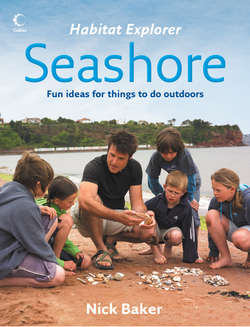Читать книгу Seashore - Nick Baker - Страница 7
Timetables of the tides
ОглавлениеThe tide – that’s the rise and fall of the ocean – pretty much shapes life on the shore and affects how it behaves at certain times. Many shore creatures have life cycles tied in with these pulses of the ocean and the tide also affects how and when we can explore the shore. So just a little understanding of this will add another dimension to your activities and avoid disappointment. It will also help you to avoid getting trapped by an incoming tide.
Why does the sea come in and go out? Well, it’s all down to the forces of gravity. The Moon and the Sun have a gravitational pull on the water in our oceans: imagine invisible strings attached to the sea tugging at the water and causing it to bulge out of shape. As the Moon rotates around the Earth every 28 days and the Earth spins around the Sun, the relative position of all three changes all the time, but in a predictable way. That is why we have tide timetables that you can get off the internet, a local newsagent or the TV weather. It works just like a bus timetable, but it is more reliable.
When the Sun and Moon are in line with each other, the pull on the sea is greater than when they are at right angles. The greater the pull, the higher and lower the tides. When the Sun is closest to the Earth we get especially strong effects and these are known as Spring tides. This happens in March and September. These largest tides (and those that occur around them) are some of the most useful to the naturalist, because the water goes out so far on a Spring tide that it gives us a glimpse of life beyond the usual tidal limits. Exciting times for a shore explorer!
When the Sun and Moon are at right angles, the pull on the sea is at its weakest and we have what are known as Neap tides. At this time, the water sometimes hardly seems to move.
But the most important thing for a naturalist to know is the daily tidal pattern, which means you usually get two high tides and two low tides a day. These high tides are separated by approximately 12 hours and 25 minutes and that 25 minutes means that every day the high tides are later by about 50 minutes.
Following the retreating water is a good way to work the beach. You can take your time and see the effects that the receding tide has on the animals that live there. It also means that you will have maximum time to explore the lowest parts of the shore before the tide turns and covers everything up again!
Take my advise
I really hate rules and regulations; they seem to go against the grain when it comes to exploring. However, there are a few safety tips that I strongly suggest you think about when down on the coast.
Tides Be aware of how fast the tide is coming in! It is very easy to get distracted by what a limpet may be doing only to look up and find that huge expanse of rocky coast has become an island and, what’s worse, you are on it! On some shallow, sloping shores, the tide can come in almost at walking pace, so it pays to do your research first. A beach that has a cliff can be dangerous, too – if you are not familiar with ways up and off the beach, the rising tide could cut you off, which is particularly risky if the high water comes right up to the cliff base.
Getting wet Try to avoid swimming in fast-flowing water or at locations that are subject to strong tidal currents. It is all too easy to get swept away.
Buddy up – always swim with a partner. In case one of you gets into difficulties, it is twice as easy for two to get out of trouble as one.
